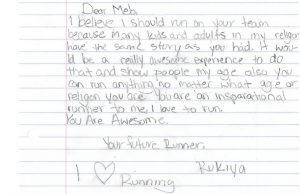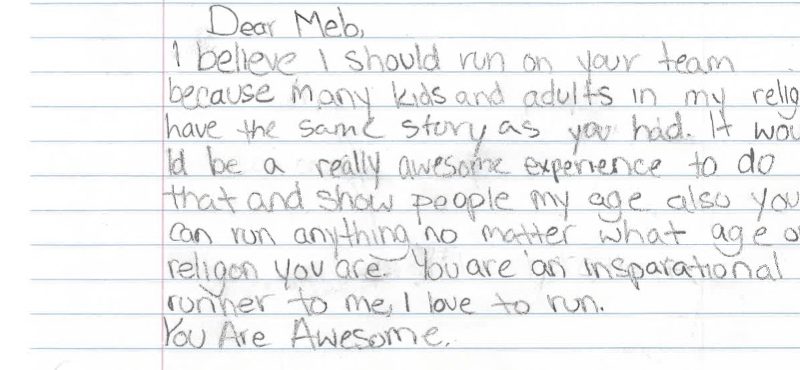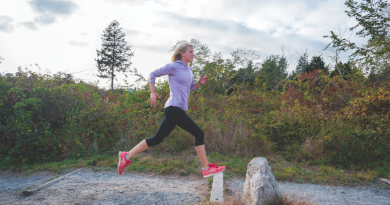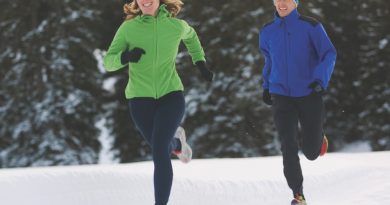This Team Of Vermont City Marathon Runners Couldn’t Be More Inspiring
On May 27, Meb Keflezhigi will race at the Vermont City Marathon. He’ll run alongside Vermonters with equally inspiring stories.
Meb Keflezhigi is hard to miss. At 43, he is lean and sinewy, a body sculpted by years of running. He
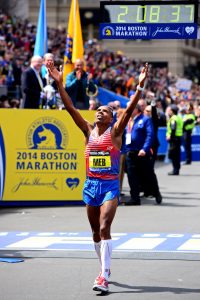
is 5 feet, 5 inches. His marathon race weight hovers around 121 pounds and he has never weighed more than 138.
Growing up in Eritrea, one of ten kids in his family, Keflezhigi didn’t see a car until he was 10 years old. His family fled the increasing violence in his country and emigrated to Italy and then San Diego. Life changed quickly in the U.S. In seventh grade, Meb ran a 5:10 mile. His running career was starting.
Since then, Keflezhigi has gone on to win the silver in the Olympic marathon in 2004. He won the New York Marathon in 2009 and in 2014 he became the first American man to win the Boston Marathon, with a time of 2:08. This May, he’ll toe the line at the start of the Peoples United Bank Vermont City Marathon. He’ll run for the first relay leg, and maybe a little longer, but then he’ll stop, letting the rest of his team take it home, and wait at the finish line.
That relay team will be just as inspiring as he is.
To celebrate 30 years of the Vermont City Marathon, RunVermont and the Vermont Department of Tourism invited Keflezhigi to Burlington for the event, not just to run it but to inspire others.
“We wanted to put together a relay team made up of people who had inspiring stories,” says Jess Cover of RunVermont. After putting out a call for essays, RunVermont chose the following four runners to join Keflezhigi in the race. Here are their stories.
Brooke Pietrafesa, 20, University of Vermont
Brooke Pietrafesa had no idea what was happening when a small crowd gathered around her at the University of Vermont indoor track during practice this spring. As the TV cameras started to roll, the University of Vermont junior learned that she’d been selected as one of Meb’s team. It was a moment she’d been working for since a fateful accident near her home in Westchester, New York. Her story earned her a spot on the team.
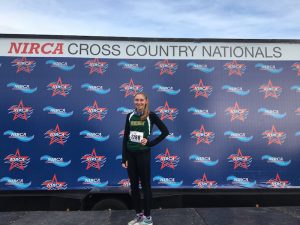
It was a warm, sunny summer afternoon in late July when a single split second changed my life. As I sat in the passenger seat of my grandmother’s tan Toyota Corolla in my cotton t-shirt and shorts, the hot afternoon sun streamed through the window. The windows were rolled down and a summer breeze blew through the car, whipping the long hair in my ponytail around. I wondered what we would be doing at cross country practice today as we drove to Crawford Park, near my home in Rye, N.Y., a route that was all too familiar.
As we crossed a heavily trafficked four-way intersection, a bright ash of metallic silver paint caught my eye. Impact. My head driven into the dashboard. No airbag to catch me. My ears ringing. My head throbbing. The world spinning around me.
Stumbling out of the totaled vehicle I saw bright flashing lights. Sirens screaming out, my world spinning sending me into a dizzying confusion. Men in uniform strapped me to a stretcher and hastened me to an ambulance. I saw familiar faces but couldn’t put names to them. This intersection looked familiar, but I couldn’t remember where I was, or who I was, for that matter. Loud doors closed at my feet. Everything faded to black. Through strobing moments of consciousness all I could see were ceiling tiles rushing by like trees whizzing past a car window.
Through my half-conscious state, I could just barely make out the disheartening words the doctors spoke: “Fractured skull. Bleeding brain. Concussion. Lacerated spleen.” I was hooked up to a respirator and fighting to stay alive. Catheters lined my arms. The doctors were unsure that I would survive, let alone be able to run again.
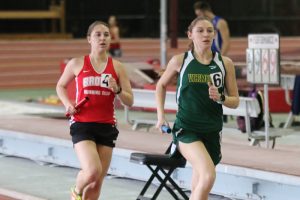
Unable to leave my bed or even sit up, the ICU became my new home for the next two weeks. Slowly, my memory came back, but the images of the accident haunted me, replaying on an endless loop in my mind. A fractured skull and fractured memories became my reality in those waning summer days leading up to my freshman year of high school.
After those few weeks in the hospital, I was finally given the okay to be released. On shaky legs, I was escorted out of the hospital by my parents, struggling and sucking wind as I tried to just make it down the stairs and to the car. I was told that I would not be able to return to any physical activity for at least two months, depending on the healing process. I was heartbroken. I had been training all summer to run cross country, and now I could barely walk an eighth of a mile without needing a breather.
Although I couldn’t run, that didn’t mean that I couldn’t attend every practice, cheer on my team, and learn as much as I possibly could from my coach while watching from the sideline. My coach recognized my drive and determination to learn and to be a part of the team and I was promoted to team manager that season. I stood on the sideline of every race, meticulously timing my teammates and giving them words of encouragement. Finally, after two months, I was given the okay to toe the starting line once again.
With only a little over two weeks until the last dual meet of the season, I made it my goal to be able to finish a varsity cross country race. My coach promised that if I could prove to him I could finish three miles, he would register me for the race.
Those first days back felt as if I was starting from square one. My hamstrings were on fire. On every hill that I pushed myself to run up, I struggled through the pain of physical recovery just as I had fought through the searing pain of my injuries that fateful day months ago.
I was determined. I ran that last race of the season, averaging about 9 minutes per mile over the grassy cross-country course, nishing in 27 minutes 58 seconds. I proved to myself that day that I wouldn’t let any setback, no matter how large, stop me from achieving my dreams.
From that day forward, I never looked at running the same way again. I would no longer take it for granted as I did in the days before the accident. I lived every day to the fullest and acted as if any second could be my last. I was now able to push myself farther than ever before. I no longer put limitations on myself. No goal was too ambitious for me. Never again did I make an excuse at practice. I gave my all, in every workout and run that. I harnessed that drive and determination that I used to recover from injuries and put that effort into training.
Each day, month, and each year I improved exponentially. Never again did I have a bad training day. Any day that I could get out and run was a good day. In fact, days that I ran were some of the best days of my life.
Fast forward to present: I am currently a student at the University of Vermont, and my passion for running is stronger than ever. I was elected President of the UVM Running Club, which has been a far more rewarding experience than I anticipated. My passion and love for the sport has driven me to grow the club from a few runners who met maybe once a week, to a group of 30 that practices four days a week.
Every day I spread my message of positivity to all of the runners in the club. I regularly encourage runners of all abilities to join our community, as I know how hard it can be to start running after quite some time off. I emphasize to each and every one of them that hard work, determination, and a passion for running will undoubtedly help them improve. I try to pass on the ideology that every run should be cherished, and our club tries to facilitate an environment that supports that. All of my hard work and dedication to inspire and support my team has paid off. I am proud to say that this was the first year ever that the UVM Running Club women’s team qualified and successfully competed in the NIRCA Cross Country National Championships, held last fall in East Lansing, Mich. Looking back, I have come a long way from that first high school cross country race, and now proudly hold a PR of 19:40 in the 5k.
The split second that changed my life is something that I wouldn’t trade for the world. The resulting hardship has shaped the person and runner that I am today. Still to this day, I live every day like it is my last. Runners like Meb have been role models for me, showing what the human spirit can overcome. I hope to one day have the same effect on people as Meb has had on me and many other runners around the world.
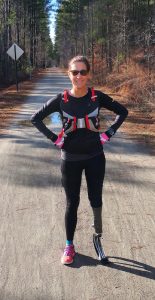 Jacky Hun-Broersma, 35, North Carolina
Jacky Hun-Broersma, 35, North Carolina
Jacky Hunt-Broersma didn’t start running until she was 33. That was in 2016, and after she had lost a leg. Her husband was a runner and it was good way for the mother of a five-year-old and seven-year-old to stay in shape and spend time with him. But that wasn’t enough for this North Carolina woman. For Jacky, running became a way to regain her life. Last year, she competed in her first marathon, Chicago, qualified for Boston and will race Burlington on Meb’s team.
I lost my leg to cancer in 2001. Since then, I have worked hard to make sure I could do everything the same way that I did before the amputation.
I wanted to stay “normal.” That is why I started running in 2016. I also thought it would be something nice to do with my husband who has been a runner for years. The only problem was that I didn’t have a prosthetic leg to run with and my walking leg was heavy and uncomfortable.
So, I started to search for a prosthetist who could make me a running blade. A running blade is very expensive. I was lucky that my insurance was willing to cover part of the cost, but I still had to contribute a few thousand dollars to the leg, so I had to be very sure that I wanted to run.
It isn’t like throwing away a pair of running shoes you don’t like. With a blade you invest a lot of money, so you can’t just decide that you don’t want to run anymore. Luckily, from the first time I tried on my blade and took a few runs, I fell in love with running and I truly felt like I was flying.
I started with running short distances and I had convinced myself I would only be a short distance runner. I really liked the 5k distance. I seemed to nd this distance easy and I even started winning races in my age group. It was an amazing feeling to compete with “normal” runners.
I added a bit more distance to my training program and I started running 10ks, but I never ran more than that. In December 2016 I ran my first half marathon. I actually signed up to run the 10k, but the day before the race I thought, why not try the half marathon and see how my blade and body handle the distance? I totally surprised myself. It’s amazing what the body can achieve if you put your mind to it.
I finished that race in 2:06 and for someone who was running on a blade, had not trained for a half, and had never run that distance before, I thought the result was pretty good. I have now gone on to run a sub 2-hour half, which I would never have dreamed a possibility. Oh, and ironically, I absolutely hated running when I had two legs.
I started to enjoy half marathons and I thought I would stick to this distance.
I always thought marathons were for the really fast and good runners and people who have been running for years, but when an opportunity came up to run the Chicago Marathon, I honestly thought, again, “Why not? Let’s see what happens.”
I obviously didn’t think clearly about what it would be like to train during the summer months. Living in North Carolina, the summers are brutally hot and humid. I started my training journey and to be honest, some runs were just awful, and I sometimes wondered why I was doing this. I’ve never wanted anyone to feel sorry for me, and that is why I work so hard.
Then I would get days when everything just came together, and my run felt amazing. I was on a runner’s high for a few days after my rst 20-mile run. Nothing beats that.
The Chicago Marathon was amazing. The crowd support helped me get to that finish line and I still can’t believe I actually did it—it is seriously one of the best feelings in the world. I remember thinking to myself at mile 20, “Why am I doing this?” because I felt like I couldn’t lift my legs anymore, but I pushed through and finished the race. When I crossed the finish line, I felt so incredibly proud. I qualified for Boston, too.
The best thing about doing any race is the support I get from my fellow runners and that I can inspire them to do better. I can’t even count the number of people who came past me and patted me on the back during the Chicago marathon, saying things like “You go girl,” “So inspiring” or “You are such a bad ass.”
I also get a lot of feedback on my Instagram account from people who didn’t feel like running, but see my post, put their running shoes on and go out for a run. I’ve had runners comment that they saw me at a local race when they were tired, but once they saw me, they realized that if someone can push through the race with one leg, then they don’t have an excuse. That is why I continue running races. I also have my motto: “What is your excuse?” on the back of a few of my running shirts.
I’ve been asked a few times what it feels like to be an amputee runner. Am I prone to more injuries? You can compare it to wearing a really nice pair of cushioned shoes that give you a really nice bounce. But you have to get used to it and it takes time to build up trust with the blade.
I get injuries just like any other runner, but often injuries will happen on my good side as my good leg takes more of the impact when I am running. I normally wear a thigh compression on my leg to protect my IT band. I also get issues with blisters on my stump which can seriously knock you for a few days, as you can’t put a Band-Aid on it and continue. Thank goodness that doesn’t happen often.
The weather does crazy things to my stump. In hot weather my stump gets swollen, so my leg doesn’t always t well. In cooler weather my stump shrinks so my leg can slide off. This has happened before. I have learned to work around it. In summer, I sleep with a compression sock on my stump to keep it from swelling too much. In winter, I just go with the flow. Sometimes I have to stop to pull my leg back up. At least I have never fallen at on my face.
People ask me if I need to buy both shoes. Unfortunately, I do. But I always ask the shop assistant if I can get half price. It is hilarious to see their expressions as they don’t know what to do. They don’t want to discriminate against an amputee, but they have also never dealt with a question like that before. I have a lot of brand new left shoes in my cupboard so if anyone is looking for size 9.5 left shoes, please contact me!
Maxwell Curtis, 26, Milton, Vt. 
Even before he started training for triathlons, running was a big part of Maxwell Curtis’s life. Growing up in Milton, he was state champ his senior year of high school—with a PR of 1:59 in the 800 meter. In college at Paul Smith’s he started getting into half marathons and loved them, earning a half PR of 1:15:32. And in 2016, he ran his first marathon at Quebec City, with a time of 2:48:56, which qualified him for the Boston Marathon. Then came triathlons and the bike accident. Curtis, a Vermont-certified arborist, explains:
Last July, I had planned to volunteer at the Ironman in Lake Placid, N.Y., in part, so that I could be eligible to compete in the Ironman competition this summer. A few days before the trip, I was training for my fourth triathlon when I was struck by a car while on my tri-bike. I do not recall the accident but was told the driver had just answered a call on his cell phone when he drove into me.
I flew 20 feet before landing on the roadside. The left side of my skull was fractured, my left hand broken, and left knee badly bruised; my new tri-bike was totaled. I awoke from a coma ten days later and began the process of healing and recovering from the fractures and a traumatic brain injury. Due to injuries to my brain, it was unknown as to what level of recovery I would reach. A lot of people prayed for me in the months that followed. My church, family, friends, medical and rehab teams supported me throughout.
When I awoke from the coma, I was not able speak, eat, drink, walk or make sense of what had happened to me. Eventually, with help from the PTs, I learned to stand, eat, walk and talk again. I was released in September to continue my healing at home as an out-patient.
In October, I started running up and down the driveway at my house. By December I was able to drive again. Now, my buddy Brent and I meet regularly to run and train together, and I am back to work and physically healthy. I will be ready to race in May!
The speed and level of my recovery has greatly surpassed what my doctors had expected. I still have some short-term memory loss but have gained a new appreciation for my health and great empathy for those who struggle with theirs.
The Vermont City Relay will be my first competitive race since the accident.
Rukiya, 11, Burlington, Vt.
For over 14 years, the RunVermont Junior Milers program has been helping youth ages 11-18 train to participate in the relay portion of the People’s United Bank Vermont City Marathon & Relay. Over the 12-week training, program participants practice as an entire team twice a week where they are guided by volunteer coaches and local partners. By partnering with local organizations such as the Boys & Girls Club, King Street Youth Center, YMCA and the Sara Holbrook Center RunVermont has been able to provide opportunities for youth who might not know where they fit or realize what their capabilities are. Rukiya’s entry was submitted by elite runner Aliza LaPierre, who works with the Junior Milers.
Rukiya, from the King Street Center, started as a RunVermont Mini Miler two years ago. Now in 6th grade, she has transitioned into the Junior Miler program.
Rukiya’s family is originally from Somalia and spent many years in a refugee camp in Kenya. The family has faced many obstacles in their search for a better life. The United States has provided safety and hope for the family, but challenges are still a part of reality. Being Muslim means Rukiya has to play sports, including running, covered. When hearing about Meb Keflezighi, Rukiya felt like she could relate to his story and now sees him as an inspiration as a runner and as a person.
Having the chance for Rukiya to run as a part of Meb’s team is one that is invaluable. Joining Meb on a 5-person People’s United Bank Vermont City Marathon team represents everything good about the sport of running and gives her the chance to toe the line with one of the greatest runners our country has ever seen without race, nationality, ethnicity, religion or economics forming a barrier.
